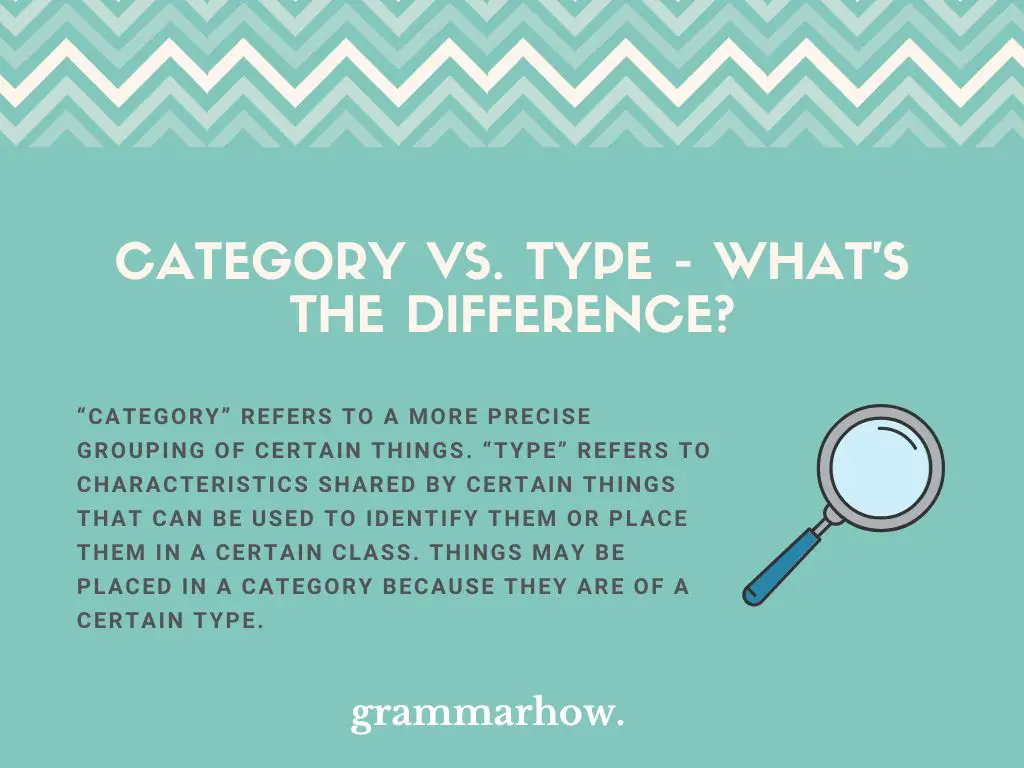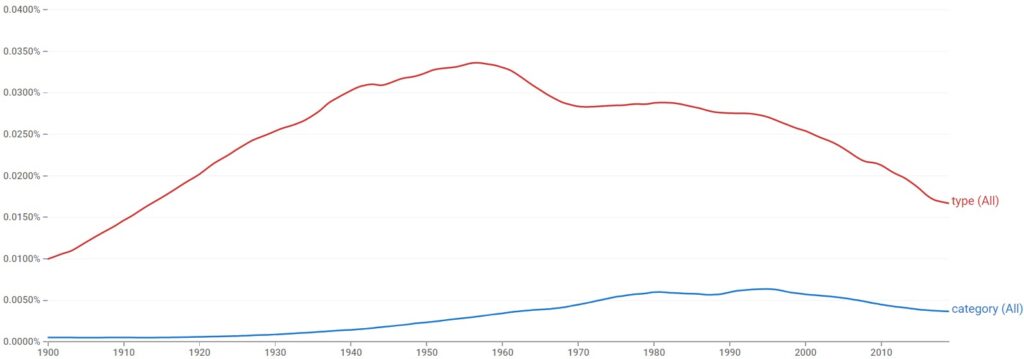Is there a difference between “category” and “type”? On paper, these words seem completely synonymous. But English is a tricky language, full of nuances and subtleties that make all our jobs harder.
So, what’s the difference between these terms? Read on to find out.
Category vs. Type – What’s the Difference?
“Category” refers to a more precise grouping of certain things. “Type” refers to characteristics shared by certain things that can be used to identify them or place them in a certain class. Things may be placed in a category because they are of a certain type.

If you’re a native English speaker, you probably haven’t given much thought to the difference between “category” and “type”. They mean similar things, yet English speakers know intuitively when to use one over the other.
Consider this sentence for example:
- A tomato is a type of berry.
This sentence implies that a tomato shares certain characteristics with berries and can therefore be classified as such. Now, let’s see if “category” can be used interchangeably here:
- A tomato is a category of berry.
The awkwardness of this sentence shows that these terms are not quite the same. A tomato cannot be a category since it’s a single item. It can, however, fall into a category.
If A is a type of thing, it can be categorized as that type of thing. So, a more correct sentence would be:
- You can place tomatoes in the “berries” category.
- Tomatoes are a category of berries.
The first sentence implies that because tomatoes are a type of berry, they can be placed in the same group as other berries. The second sentence implies that there are many types of tomatoes, but all tomatoes are berries. Thus, they form a category on their own, within the broader “berry” category.
In short, you can have a category containing types of things, and you can have certain types of categories.
Category
A “category” refers to a group or subgroup of things that share certain characteristics.
The Cambridge Dictionary provides the following definitions for this term:
- (in a system for dividing things according to appearance, quality, etc.) a type, or a group of things having some features that are the same
- a group of people or things that have similar features
As you can see, even the definition of “category” contains the word “type”. This explains why these words are frequently seen as interchangeable.
However, “category” is generally used when certain things are grouped together on the basis of their shared features. Consider the following examples:
- You can put these birthday cards in the “junk” category – I don’t even talk to those cousins anymore.
- The music that emerged from Zambia in the 1970s was similar to rock but didn’t fit comfortably in this category due to its mix of African music with funk and blues.
- You can choose one of three categories for the pop quiz: history, science, or politics.
- Those in the professional category can earn up to triple that of the amateur category.
- All these films belong to the same category, despite their different genres.
Type
A “type” refers to something that shares characteristics with another thing and can therefore be classified in relation to that other thing.
The Cambridge Dictionary defines “type” as “a particular group of people or things that share similar characteristics and form a smaller division of a larger set”.
Is it just us, or does this definition look suspiciously similar to the one for “category”? Like we said, what makes these terms tricky is how similar they are. Yet, intuitively, English speakers know not to use them interchangeably.
Consider these example sentences for the word “type”:
- I don’t really have a type when it comes to men or women; I think everyone is uniquely beautiful.
- It looks strange and unearthly, but it’s actually a type of fish.
- I can’t decide what type of dress I should choose for my wedding: modern or vintage?
- He doesn’t seem like the type of person to leave without saying goodbye.
- I’ve never been the jealous type, but I won’t be made a fool of!
- It had been a while since he’d felt that type of emotional vulnerability.
There’s no way to insert “category” into these sentences without making them look clumsy. This is mainly because individual objects cannot really be a category. They can only be in a category or of a type.
Is “Category Type” Correct?
Technically, you could have a type of category or a “category type” as the case may be.
Since a category is a grouping of things based on their features, it’s technically correct in English that there can be a group or category of a certain type.
- I don’t think it will work if we place it in this type of category.
- This category type isn’t suited for this particular genre of music.
These sentences seem to make sense. They also illustrate the subtle, intuitive differences between “category” and “type”.
Which Is Used the Most?
A look at the Google Ngram Viewer shows that “type” is used far more in English than “category”. This has been the case for over a century!

The fact that “type” is a smaller, simpler word means it probably gets used more frequently than “category” in most contexts.
Additionally, unlike “category”, type has a few more meanings and can therefore be used in a wider scope of contexts. For example, type also means to type on a computer or typewriter.
“Type” is used most in both British and American English as well. Guess it’s just the type of word we all prefer to use!
We’ll see ourselves out.
Final Thoughts
Although “type” and “category” have similar meanings, English speakers tend to use them for different purposes. “Category” tends to be used to refer to a grouping of things based on their shared characteristics. “Type” tends to refer to the class of thing that may be categorized based on its characteristics.

Martin holds a Master’s degree in Finance and International Business. He has six years of experience in professional communication with clients, executives, and colleagues. Furthermore, he has teaching experience from Aarhus University. Martin has been featured as an expert in communication and teaching on Forbes and Shopify. Read more about Martin here.
